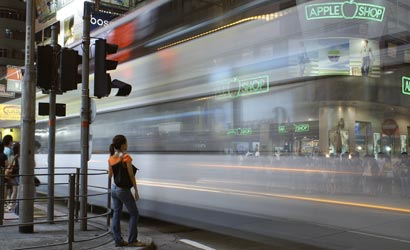You Can Do It: Night Moves
A tripod and long exposure help capture the motion of a bustling city.

Since getting my first DSLR, the world of photography has opened up to me. Previously, the expenses of film photography, plus the time lag between shooting and actually seeing results, were barriers to experimentation and learning for me. Digital provided access to both. The photo here was the result of just such a process.
Close to midnight one night last September, the high-energy nightlife of Hong Kong’s Mong Kok district swirled around me, and I made this picture with a Konica Minolta Maxxum 5D, an 18-70mm f/3.5-5.6 (D) kit lens, and a Manfrotto 055PRO tripod with a 486RC2 quick-release ballhead.
I spent a couple of hours trying out different vantage points, perspectives, and compositions. When I came to the intersection, about an hour into shooting, I saw the image in my mind’s eye, planted my rig, and waited until someone stopped and stood, forming an anchor-like focal point in the midst of the urban chaos. There were many people and buses, and I didn’t have to wait long for the elements to come together.
The scene was lit entirely by ambient light, of which there was plenty. There was so much light, in fact, that I needed a Cokin neutral-density filter — which I luckily had packed — to keep overexposure from ruining the shot at the long shutter speeds required to blur the traffic.
Shutter speeds. Wow! Choosing the right one was a challenge I met only after much trial and error. I made many pictures, all in the shutter-priority mode, each one closer to what I’d originally visualized and each one motivating me to take more photos. If I hadn’t been shooting digital, with its instant feedback, I doubt I could have succeeded. Eventually I landed on 0.8 sec and f/10, at ISO 100.
The zoom setting was 26mm, the 35mm equivalent of about 39mm. I might have gone wider, except I wanted to avoid the vignetting that sometimes occurs in the corners of my ultrawide photos made with lens-mounted filters. With a thin-profile screw-on filter or a special wide-angle Cokin holder, vignetting wouldn’t have been a problem. But I had neither, so 26mm it was.
Almost anyone can make photos like this with a camera that allows for control of shutter speeds. You only need to…
• Find a location with abundant ambient light and nighttime activity.
• Be patient; don’t expect to get the keeper right away. Take a lot of photos.
• Don’t forget the tripod. Without one, this shot is impossible. It’s easy to feel self-conscious setting up a tripod on a busy sidewalk — get over it. People are not as bothered as you think.
• Don’t be afraid to take your camera out of Auto mode and experiment with different shutter and aperture settings.
• Visualize what you want in advance and pay close attention to composition and details. It’s very easy to be distracted by the activity when you are in such a high-energy setting. Resist this! Such pictures can be easily ruined, for example, by someone looking at the camera and smiling. Be alert.
• Have fun!
Married with two children, Steve Webel, 33, is a Florida native who is currently studying Mandarin in mainland China. Discover more of his work at flickr.com/photos/webel.